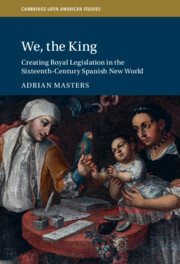Book contents
- We, the King
- Cambridge Latin American Studies
- We, the King
- Copyright page
- Dedication
- Contents
- Figures
- Tables
- Acknowledgments
- Prelude: A Peruvian Mestizo at the Spanish Court
- Introduction
- 1 Paper Ceremonies for a Global Empire
- 2 The Cocreation of the Imperial Logistics Network
- 3 Distant Kings, Powerful Women, Prudent Ministers
- 4 Lawmaking in a Portable Council
- 5 “Bring the Papers”
- 6 Creating the Royal Decree
- Pedro Rengifo’s Epilogue
- Conclusions
- Glossary
- Bibliography
- Index
- Other Books in the Series (continued from page ii)
6 - Creating the Royal Decree
Format, Phraseology, and Petitioners’ Transformation of Indies Law
Published online by Cambridge University Press: 02 March 2023
- We, the King
- Cambridge Latin American Studies
- We, the King
- Copyright page
- Dedication
- Contents
- Figures
- Tables
- Acknowledgments
- Prelude: A Peruvian Mestizo at the Spanish Court
- Introduction
- 1 Paper Ceremonies for a Global Empire
- 2 The Cocreation of the Imperial Logistics Network
- 3 Distant Kings, Powerful Women, Prudent Ministers
- 4 Lawmaking in a Portable Council
- 5 “Bring the Papers”
- 6 Creating the Royal Decree
- Pedro Rengifo’s Epilogue
- Conclusions
- Glossary
- Bibliography
- Index
- Other Books in the Series (continued from page ii)
Summary
This chapter explains the council and king’s ratification of hundreds of thousands of royal decrees, and the unique categories that these edicts contained, such as mestizo and mulato. It outlines the pathways through which vassals of all social backgrounds suggested new laws to the ruling Council of the Indies. Pressed for time, the council’s overwhelmed ministers often transplanted petitions’ vocabulary verbatim into decrees. This meant that subjects often phrased imperial laws minor and major, regional and Indies-wide. Using a multistep archival methodology, this chapter demonstrates how scholars can match vassals’ petitions to decrees, then shows how legal categories such as mestizo and mulato came about through the petitions of not only Spaniards but also Indians, mestizos, and mulatos themselves. Subjects of any social background could therefore introduce and shape Indies legal constructs, and the empire’s agenda from the ground up. It considers the lawmaking royal signature, as well as some vassals’ dangerous decision to attempt its forgery. Lastly, it reflects on the nature of the de partes/de oficio divide in decree production, the number of gobierno royal decrees, and the costs of their production for vassals.
Keywords
- Type
- Chapter
- Information
- We, the KingCreating Royal Legislation in the Sixteenth-Century Spanish New World, pp. 221 - 256Publisher: Cambridge University PressPrint publication year: 2023

